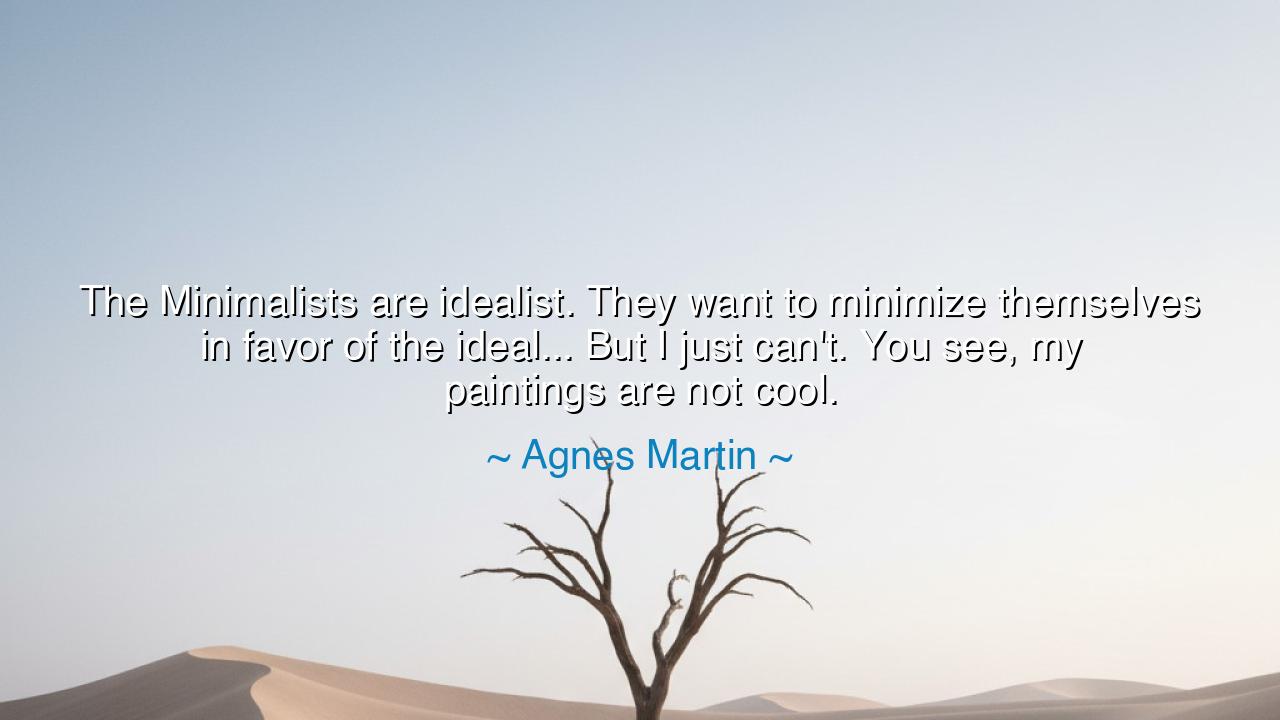
The Minimalists are idealist. They want to minimize themselves in
The Minimalists are idealist. They want to minimize themselves in favor of the ideal... But I just can't. You see, my paintings are not cool.






“The Minimalists are idealist. They want to minimize themselves in favor of the ideal... But I just can’t. You see, my paintings are not cool.” Thus spoke Agnes Martin, the quiet mystic of modern art, whose soft grids and gentle lines conceal an ocean of emotion. Her words, spoken with humility yet charged with conviction, reveal the eternal tension between perfection and humanity, between the artist who seeks the divine ideal and the one who embraces the trembling beauty of imperfection. In this simple declaration—“my paintings are not cool”—Martin speaks not of temperature, but of spirit. She defends warmth, vulnerability, and feeling in a world that often worships the cold precision of intellect and form.
To understand the origin of this quote, one must step into the world of the Minimalists, those painters and sculptors of the 1960s who sought purity above all. They stripped art of expression, leaving only the form—the square, the line, the plane. Their works were immaculate, austere, and detached from the artist’s hand. Agnes Martin was often placed among them, for her canvases seemed spare, her compositions geometric. But within her heart, she was no true minimalist. Where they sought the ideal, she sought the ineffable—that faint light of transcendence that moves quietly through human experience. For her, the grid was not a symbol of order, but a vessel for emotion; not a denial of life, but a meditation upon it.
When she said the Minimalists “want to minimize themselves in favor of the ideal,” she was naming their pursuit of transcendence through erasure—the attempt to remove the artist’s touch so that the idea alone might remain. But Martin could not erase herself. “I just can’t,” she admits—not with defiance, but with truth. For within her flowed a tenderness that could not be silenced. Her art may appear still and quiet, but beneath that stillness beats the pulse of feeling, the ache of existence, the longing for peace that all humans share. Her grids breathe, shimmer, and dissolve like sunlight through mist. They are not “cool,” because they are alive.
This confession echoes through the ages, for every true artist must face the same question: Shall I serve the ideal, or the human? Shall I seek perfection, or truth? The poet Homer sang of gods and heroes, but his greatest power lay not in their perfection, but in their sorrow and pride. Michelangelo, who carved marble as if it were air, left his statues forever incomplete—not as failure, but as revelation, for even the divine form yearns toward something beyond itself. Agnes Martin, too, embraced incompleteness. Her paintings do not demand awe—they invite contemplation. They are not monuments to reason, but prayers of serenity.
There is, in Martin’s words, a kind of rebellion against the coolness of intellect, the sterility of art that forgets the heart. She understood that to make something truly eternal, one must fill it not with detachment, but with love. “My paintings are not cool,” she said, because they are kind. They speak softly to the soul, reminding it that stillness is not emptiness, and that simplicity, when born of compassion, becomes sacred. The Minimalists sought the perfect form; Martin sought the perfect feeling—the point where calm and wonder meet, where art becomes a mirror for the inner life.
Her words are not only for artists, but for all who live in a world that prizes efficiency over emotion, progress over peace. The lesson is clear: do not erase yourself for the sake of ideals. The world does not need perfection—it needs presence. In your work, in your love, in your living, do not seek to be cool, polished, or untouched. Seek instead to be true. Let your flaws reveal your humanity, and your humanity reveal your depth. For warmth, even in silence, gives life to all that is beautiful.
So, my listener, remember this wisdom of Agnes Martin: The pursuit of the ideal must never drown the pulse of the soul. In a time when the world races toward abstraction and detachment, be the one who brings feeling back to form, who dares to make work that breathes, trembles, and forgives. Whether your art is made of words, deeds, or dreams, do not fear to say, as she did, “I just can’t.” For in that refusal lies not weakness, but courage—the courage to remain human in the face of perfection, and to remind the world that coolness may command respect, but warmth alone creates love.






AAdministratorAdministrator
Welcome, honored guests. Please leave a comment, we will respond soon